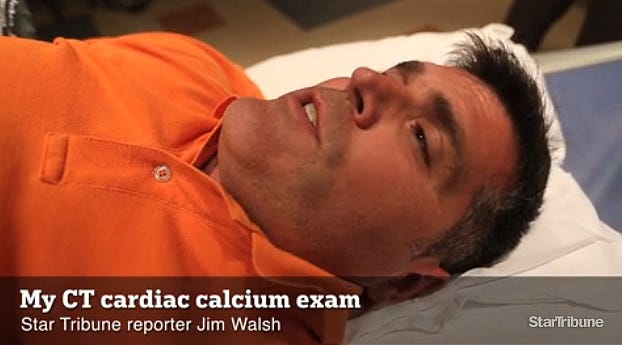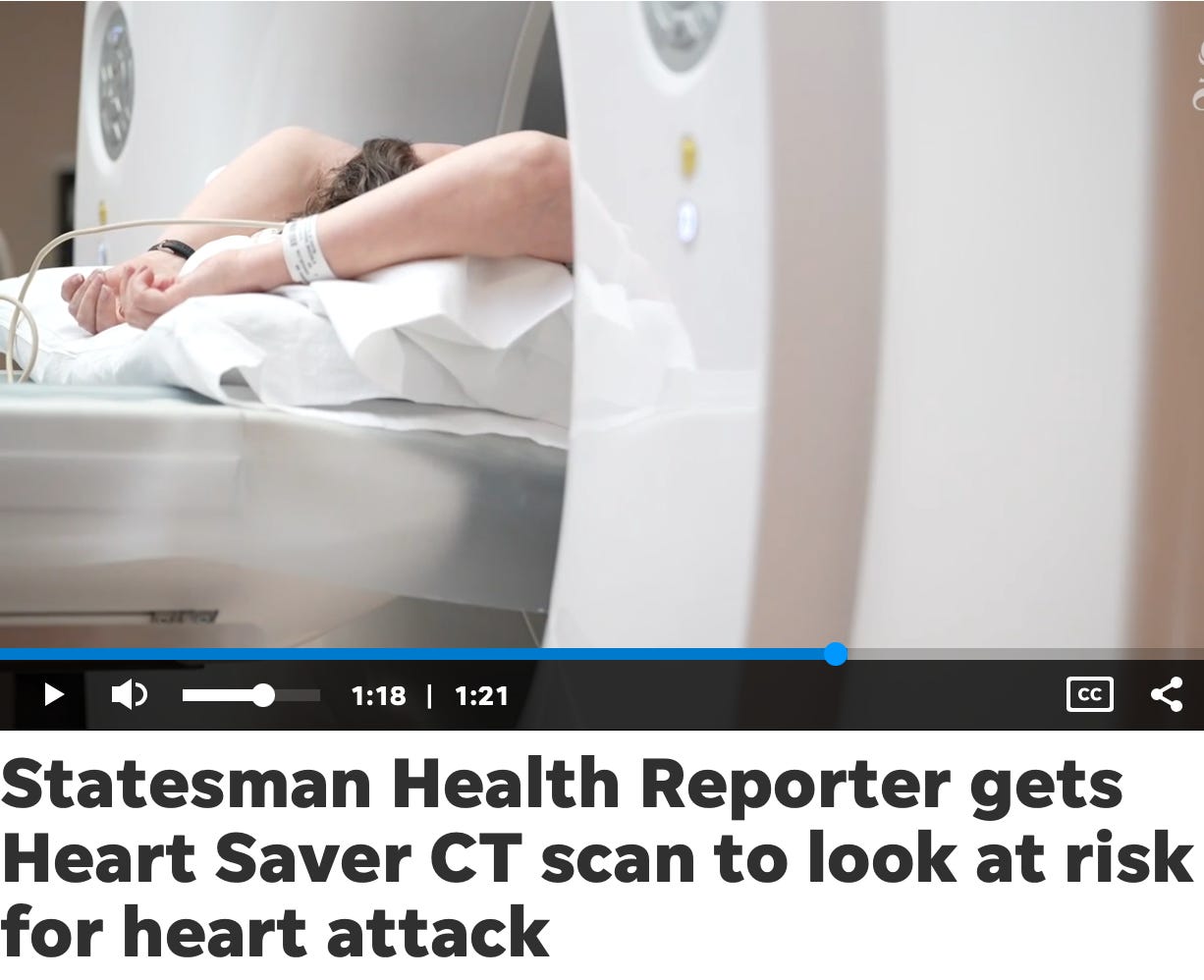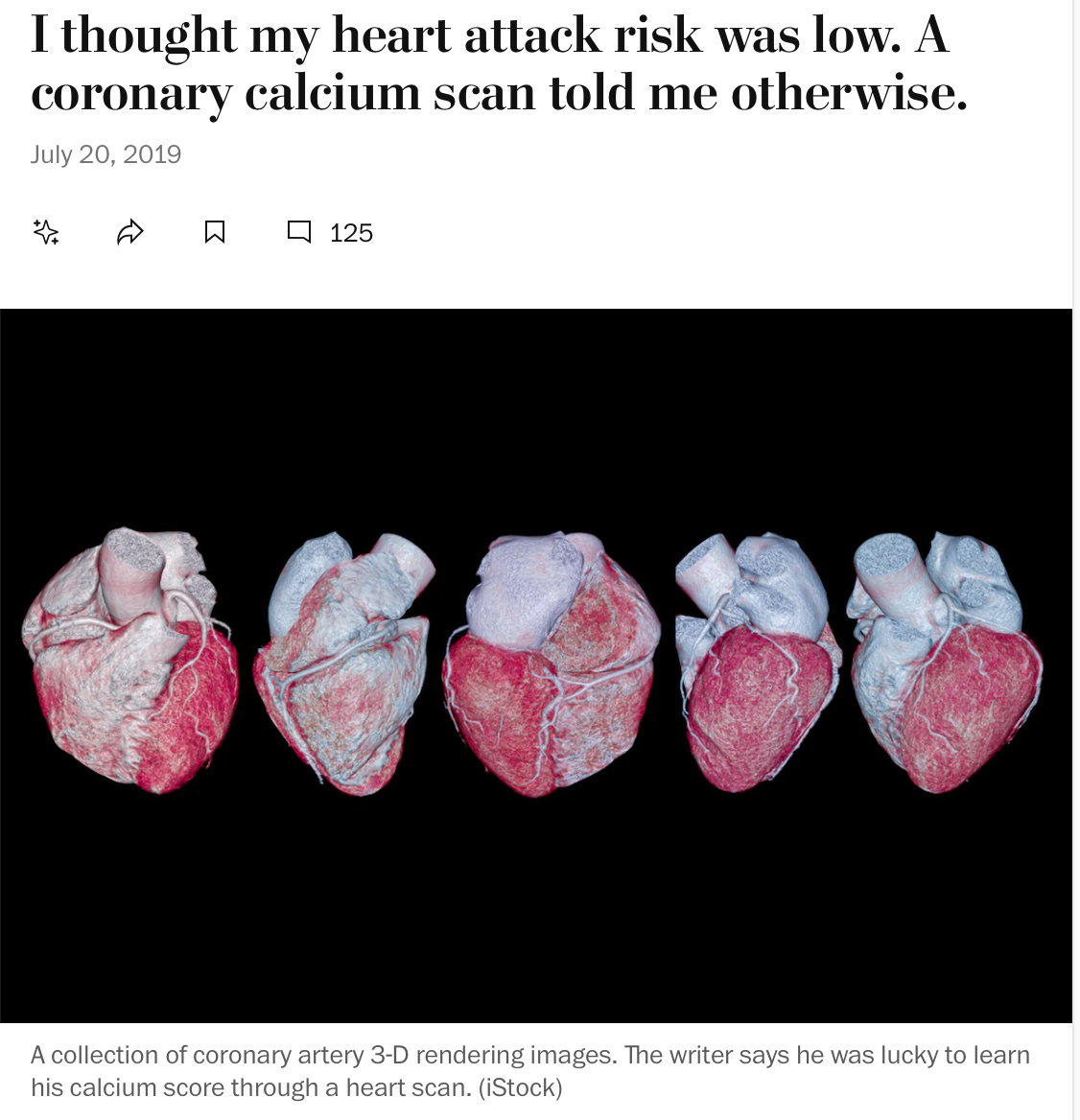For years I’ve followed the often fawning news coverage of coronary artery calcium (CAC) scoring with CT scans. Most troubling to me were the stories reporters told about themselves getting scanned - sometimes because a hospital offered to scan them for free. I’ve written about this practice before because it aggravates me to no end.
13 years ago I wrote, “If hospital PR people offer heart scans, should journalists bite?” It’s still a worthwhile read.
Clearly, reporters who like to put their face (and more) on TV are still buying the pitch from hospital PR people, as in this 2022 example.
In 2023, another Minnesota journalist reported on her own scan, below.
In 2024, a Cleveland TV station showed a reporter getting the scan on live TV.
Just last month, a Springfield, Missouri TV station featured 4 of its reporters - and a local clergyman, who had CAC scans.
But big-time print publications also get in on the act.
2024: Fortune - Reddit cofounder calls this ‘the highest ROI $100 you can spend on your health.’ Here’s what to know about the calcium score test’s benefits
2021: The New York Times - Should I take a heart drug? A coronary calcium scan may help you decide.
2019: The Washington Post - I thought my heart attack risk was low. A coronary calcium scan told me otherwise. (Another journalist telling his own story - not my favorite genre, as you’ve seen.)
Sounds like a slam dunk, doesn’t it?
Not so fast.
The US Preventive Services Task Force - a group of independent volunteer physicians and researchers that analyzes the evidence for preventive services - concluded in 2018 that:
the current evidence is insufficient to assess the balance of benefits and harms of adding (tests including the) coronary artery calcium (CAC) score to traditional risk assessment for cardiovascular disease (CVD) in asymptomatic adults to prevent CVD events. … Direct evidence from adequately powered clinical trials evaluating the incremental effect of the … CAC score to improve health outcomes is lacking.
The USPSTF says that “an update for this topic is in progress.” To be sure, the jury is still out.
Meantime, there’s been a recent flurry of articles about the scans and scoring.
On February 27, physician assistant Zachary Robert Caverley wrote, “Questioning coverage for coronary artery scans.” He wrote that despite the promotion of the test as a powerful predictive tool, in the US it still is paid for mainly by patients and not insurance. And he thinks that’s OK for three main reasons:
There is no current evidence that CAC scoring saves lives.
CAC score prices are already declining.
More coverage means more inappropriate testing.
He concluded:
Until there is clear evidence of mortality benefits, keeping CAC scoring as an out-of-pocket expense may be the most prudent approach to balance access, cost, and clinical utility.
On March 5, the Journal of the American Medical Association (JAMA) published the results of a randomized clinical trial of CAC scoring, concluding that it’s a “rapid and reproducible adjunct to assessment in those with intermediate clinical risk.”
That same day, JAMA published another article that explored “the concepts of when CAC testing is too early, too late, or too often.” To some degree, that article reminded me of the old saying, “To a man with a new hammer, everything looks like a nail.”
On March 10, heart rhythm specialist John Mandrola, MD, wrote - “Coronary artery calcium trial fails to impress.” - about the study results published in JAMA. He provided two main reasons:
A weak surrogate endpoint. You may be able to scan the arteries and get images that show that plaque in the arteries has declined. But less plaque - a surrogate endpoint - doesn’t always lead to better outcomes.
It was a flawed comparison. Mandrola wrote:
The authors suggest that a nurse showing patients an image of the scan helped them live better over the three years, which then led to better scans.
But the nurse-led group also received a medicine known to reduce LDL cholesterol while the other group did not get the statin. I don’t see how CAC figures in the outcome given this huge difference in strategy.
Six years ago Mandrola and a colleague wrote an article - “The case against coronary artery calcium scoring for cardiovascular disease risk assessment” - and he stands by that argument. It began:
The Internet overflows with stories—often from tech titans—where a CAC scan led to a lifesaving stent in a previously unknown coronary obstruction. But we know from many clinical trials that outside of an acute MI (heart attack), revascularization (stenting) does not lead to better outcomes over simple medical and lifestyle therapy.
The reason I bring this to your attention is - as always - to help you improve your own critical thinking skills about medical interventions. Just because something is published in a medical journal doesn’t mean it’s gospel. The jury may still be out on the value of these scans and calcium scoring. But the internet does overflow with stories every day that should not be taken at face value. You can learn how to be a healthy skeptic, how to read the limitations of a study, how to look for surrogate endpoints and realize what the limitations may be. Don’t rush to judgment based on news or social media headlines. And applaud admission of uncertainty rather than falling for certainty where it doesn’t exist.












We use multiple tests and data points to predict risk. I use the CAC as just another test to help predict. It can be helpful in younger patients who don’t want to take lifelong statins. It can also be helpful in promoting lifestyle changes. Some people want to”proof”.